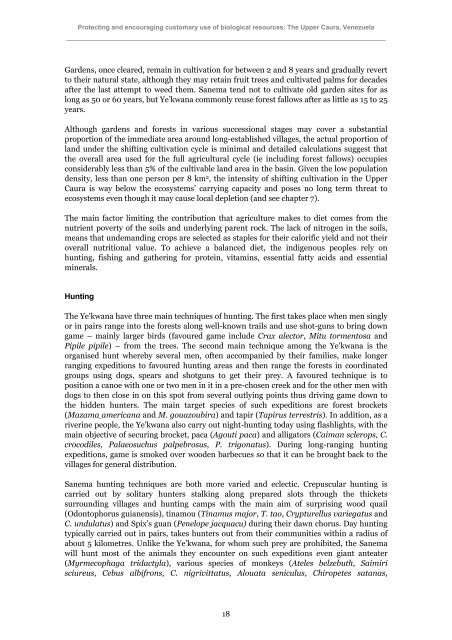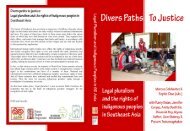The Upper Caura, Venezuela - Forest Peoples Programme
The Upper Caura, Venezuela - Forest Peoples Programme
The Upper Caura, Venezuela - Forest Peoples Programme
You also want an ePaper? Increase the reach of your titles
YUMPU automatically turns print PDFs into web optimized ePapers that Google loves.
Protecting and encouraging customary use of biological resources: <strong>The</strong> <strong>Upper</strong> <strong>Caura</strong>, <strong>Venezuela</strong>_________________________________________________________________________________________Gardens, once cleared, remain in cultivation for between 2 and 8 years and gradually revertto their natural state, although they may retain fruit trees and cultivated palms for decadesafter the last attempt to weed them. Sanema tend not to cultivate old garden sites for aslong as 50 or 60 years, but Ye’kwana commonly reuse forest fallows after as little as 15 to 25years.Although gardens and forests in various successional stages may cover a substantialproportion of the immediate area around long-established villages, the actual proportion ofland under the shifting cultivation cycle is minimal and detailed calculations suggest thatthe overall area used for the full agricultural cycle (ie including forest fallows) occupiesconsiderably less than 5% of the cultivable land area in the basin. Given the low populationdensity, less than one person per 8 km 2 , the intensity of shifting cultivation in the <strong>Upper</strong><strong>Caura</strong> is way below the ecosystems’ carrying capacity and poses no long term threat toecosystems even though it may cause local depletion (and see chapter 7).<strong>The</strong> main factor limiting the contribution that agriculture makes to diet comes from thenutrient poverty of the soils and underlying parent rock. <strong>The</strong> lack of nitrogen in the soils,means that undemanding crops are selected as staples for their calorific yield and not theiroverall nutritional value. To achieve a balanced diet, the indigenous peoples rely onhunting, fishing and gathering for protein, vitamins, essential fatty acids and essentialminerals.Hunting<strong>The</strong> Ye’kwana have three main techniques of hunting. <strong>The</strong> first takes place when men singlyor in pairs range into the forests along well-known trails and use shot-guns to bring downgame – mainly larger birds (favoured game include Crax alector, Mitu tormentosa andPipile pipile) – from the trees. <strong>The</strong> second main technique among the Ye’kwana is theorganised hunt whereby several men, often accompanied by their families, make longerranging expeditions to favoured hunting areas and then range the forests in coordinatedgroups using dogs, spears and shotguns to get their prey. A favoured technique is toposition a canoe with one or two men in it in a pre-chosen creek and for the other men withdogs to then close in on this spot from several outlying points thus driving game down tothe hidden hunters. <strong>The</strong> main target species of such expeditions are forest brockets(Mazama americana and M. gouazoubira) and tapir (Tapirus terrestris). In addition, as ariverine people, the Ye’kwana also carry out night-hunting today using flashlights, with themain objective of securing brocket, paca (Agouti paca) and alligators (Caiman sclerops, C.crocodiles, Palaeosuchus palpebrosus, P. trigonatus). During long-ranging huntingexpeditions, game is smoked over wooden barbecues so that it can be brought back to thevillages for general distribution.Sanema hunting techniques are both more varied and eclectic. Crepuscular hunting iscarried out by solitary hunters stalking along prepared slots through the thicketssurrounding villages and hunting camps with the main aim of surprising wood quail(Odontophorus guianensis), tinamou (Tinamus major, T. tao, Crypturellus variegatus andC. undulatus) and Spix’s guan (Penelope jacquacu) during their dawn chorus. Day huntingtypically carried out in pairs, takes hunters out from their communities within a radius ofabout 5 kilometres. Unlike the Ye’kwana, for whom such prey are prohibited, the Sanemawill hunt most of the animals they encounter on such expeditions even giant anteater(Myrmecophaga tridactyla), various species of monkeys (Ateles belzebuth, Saimirisciureus, Cebus albifrons, C. nigrivittatus, Alouata seniculus, Chiropetes satanas,18
















